Directives / Global
The new brigade
Across a broad spectrum of industries we bring you an insight into the gamechangers that we expect to see pushing the envelope over the coming months and years.
1- Ahmed Aboutaleb
The Muslim mayor of Rotterdam who is uniquely placed to speak on migration.
The Atlantic Dialogues, organised by the German Marshall Fund, is where people gather to discuss the issues confronting the nations of the Atlantic basin. We are sitting in a corridor at the Palais de Congres in Marrakech as global dignitaries and lost think-tank types cruise by looking for their next session, lanyards all a-rustle over business suits or national dress. The mayor of Rotterdam is fresh from an on-stage debate about creating equitable cities, during which he has subtly provoked an audience that is very much part of the global liberal elite (you’re no one here unless you worked to help some nation back to democracy or did a stint with President Obama). He brushes a light dew of moisture from his brow.
The mayor is a jolly type; a smile regularly jumps back and forth across his face like a budgerigar in a cage. But get him going and he can be enjoyably sparky. The budgie might peck. Today he has just told his audience that if a migrant in the Netherlands has any sympathies with Isis they should hand back their Dutch passport and leave the country. Indeed, he’s not that keen on migrants who fail to learn not just the language but the history and culture of their new home nation (and are then able to defend it). But the mayor didn’t get booed for these views. Everyone listened carefully even if their stomachs may have got the PC jitters every now and then. And perhaps that’s because the mayor’s name is Ahmed Aboutaleb and he’s the first Muslim mayor of a major Dutch city. It’s a role he has held since 2009.
While mayor Aboutaleb (pictured, below, second left) is a member of the left-of-centre PvdA (Labour) party, the right-wing Livable Rotterdam party – an offspring of the late Pim Fortuyn’s List party – has also lent him its support for a second term (in Rotterdam mayors are appointed, not elected) that runs from January 2015 to 2021. It’s an unusual line-up of supporters.
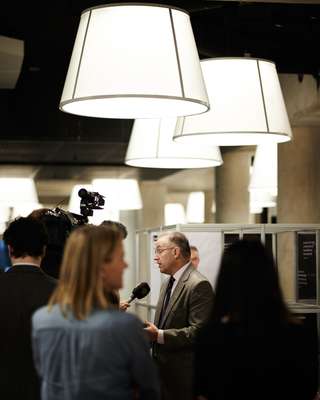
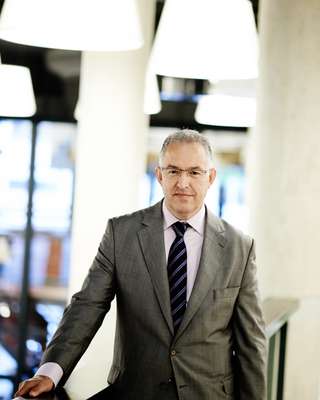

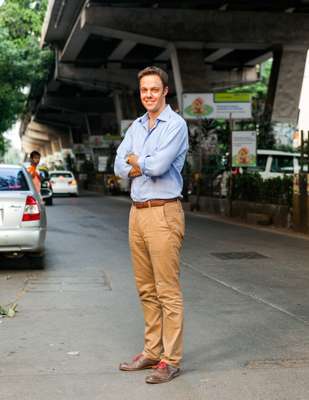


Europe is having a tricky cultural moment. Growing numbers of its citizenry are opposed to fresh migration that they often see in rudimentary terms of people coming to take their jobs. As a result they are voting for populist, anti-immigration parties that vary in tone from merely aggrieved to openly violent. And they are forcing politicians of every hue to at least try and articulate their views on this tensest of topics.
Mayor Aboutaleb’s family moved from a village in Morocco’s Rif mountains to the Netherlands in 1976 when he was a teenager. The lessons of his life (his family were keen for their children to go Dutch) and his years in politics have left him able to tackle the immigration debate without requiring any fancy footwork. He can talk to both sides. He’s hard to pigeonhole. He sees a thorny issue and comes out with a view that is about protecting both Dutch identity and the new arrivals keen to pitch in.
He may be the kind of politician we need to clone if the migration question is to get a well-deserved answer and not sink into a racist debate. Let’s allow Aboutaleb to explain: “A lot of politicians tend to think that a focus on the economic issues is what’s important to win elections. But a lot of people are scared of losing their identity. It’s not only a socio-economic approach that’s needed: it’s a socio-cultural approach.”
“So why did citizens in the Netherlands reject the EU agreement a few years ago [the Dutch voted against a draft EU constitution in 2005]? Not because they were thinking the Common Market was a bad thing but the question was the extension of Europe: what is my identity in a big area with more cultures, more languages?”
Aboutaleb doesn’t seem to follow a party script. Again this marks him out as the kind of politician who should increasingly dominate City Hall politics. Yes, he can deal with some gritty local flare-up but then he will head off around the world to represent his patch.
It’s a fittingly two-pronged approach for a city of two halves. Of Rotterdam’s 600,000 residents, only 50 per cent are Dutch; the rest are mostly from Suriname, Turkey, Morocco and the former Yugoslavia. It’s a city, says Aboutaleb, that “you cannot describe in one direction. It’s a city of hardworking, ordinary people who came to work in the port. But it’s also the city of Erasmus, the writer, the thinker.”
And it is his holding together of what could be a divided community that again marks Aboutaleb out for the future. “Cities need migration; fresh blood. But when migrants come in, unless you are a Harvard professor, you start from zero and then you have to climb step by step. So there are two parties you need to consider. First, what is the willingness of the migrant themselves to be part of this new society? It’s a mental switch. Once you decide that you will invest in your own position you will stand on firmer ground. But on the other side of the story it is not fair to ask migrants to burn all their vessels behind them. It is not ethical to do so.”
And if any migrant, or any Dutch citizen for that matter, hears this argument and wonders about its authenticity or value, they only have to look into the eyes of the man standing in front of them – the man who walked down the mountain and into City Hall. Whether expressed in Arabic, Dutch or English, he has a lesson for us all.

2- Simon Williams
Number cruncher QuantumBlack is out to make data beautiful but leave people in control.
Big data. Unless you have been living in a temple in Bhutan wearing ear muffs at all times you will, by now, have heard someone bandying this term around. It’s usually used in phrases such as: “We are mining our big data.” There’s a lot of mining involved with big data. For business owners looking for the competitive edge it is now the ingredient du jour; served up by every corporate keenster hoping to show the way ahead.
In brief, this is how we got here: people realised that they were storing ever-growing quantities of data and that, with help, they could discern useful patterns and new truths in their numbers. At this point they called in the miners, engineers who dig through the numbers and pop up with nuggets of gold. The trouble is that, until now, many of those miners have been rough old souls who didn’t know how to work that gold into something beautiful; something CEOs would behold with wonder.
And this is where QuantumBlack comes in, a company for the future in every sense. Let’s visit. Head to London’s Clerkenwell, an area that handily abuts the City; it’s next to the UK’s financial heart but also home to Smithfield meat market and myriad hip bars. Enter 12 Carthusian Street and take the lift to a beautiful office where people sit at clean desks and occasionally eddy into mini meetings. It looks a size too big for the number of people here; this is a company that is intending to grow quickly. And here comes Simon Williams, chief executive and co-founder of QuantumBlack.
Williams dresses well: not too corporate, a flash of bright sock, a pair of heavy-rimmed glasses. He explains what the company does from his glass-boxed office (so pristine that I feel a tinge of anxiety as a droplet of coffee runs down the side of my white coffee cup onto the white table). “Five years ago the term ‘big data’ didn’t really exist,” he says. “But we come from backgrounds in sport and finance, places where data has always been used to your advantage. Then McKinsey published a report on big data and it got a lexicon that everybody could understand. Today there are two classes of people in this big-data world. The first says: ‘Give us all your data and we’ll tell you something interesting.’ We tend to be: ‘Tell us what your problem is and we’ll find the data to resolve that problem.’”
Williams’ move from the sports world followed a trail of burnt rubber as he, like many of the people here, cut his teeth in Formula One. Before QuantumBlack he had a software business that developed from work he did for McLaren. So why is that F1 grounding helpful? “A Formula One team runs out many scenarios of what could happen in a race,” he says. “They trade off risk and return. They say, ‘This is what we know, this is what we expect and this is what we want to achieve.’ They play off a strategy that is risky but could win against a safer one where they might come second or third. In sport the team that has the advantage will win. Formula One has always used big data.”
Williams says that they looked at the business realm and saw that the lessons of Formula One could be applied here, too. And analysing a simple company would be easy compared to F1, where a single car might have 1,800 data streams.
By now those references to McKinsey and the desire to be the big winner may have you thinking this is all about “efficiencies”. And while Williams is keen to point out that his approach can save money, he does not wear red braces or have a McKinseyian view of people. It’s not about sacking staff.
Indeed, there’s a higher notion to consider: beauty. The CEO who has to wade through a confusion of numbers every day has, in their personal life, got used to handsome apps on their phone conveying all sorts of facts with grace. Why, the CEO wonders, can’t their company’s stats come over in the same way? Williams wants to supply the answer: to be able to turn numbers into something people want to look at.
Williams explains how his team’s special mix helps them meet this challenge. “Thirty per cent of our staff have PhDs in maths, stats, computational biology and robotics, and they are then sitting right next to people with graphic design and informational architecture backgrounds.” It makes a good marriage of data and beauty. The merging of the quantum-sciencey bit with the black arts: the magical element.
The list of clients who have called in QuantumBlack is eclectic. They have worked for an English Premier League football club, sifting data to predict when a player is most at risk of a hamstring injury. They have continued to assist in the world of Formula One and have worked for Rolls-Royce and Boeing.
Another client is doing some real mining: digging a tunnel for a new railway under London called Crossrail. Indeed, it burrows right under QuantumBlack’s offices. The company has taken the data collected from 280,000 censors that monitor movement in the soil and on buildings to predict the risk of slumping. And it has turned all those readings into a simple map that can be scanned in seconds.
Sam Bourton, chief engineer and a Quantumblack co-founder, and Yves Boussemart, the chief design officer, show me their handiwork. Bourton, who also came from F1, says: “The sensors upload a new reading every 30 minutes. The engineers can see what’s been taking place in the last 48 hours or what is happening now. They can drill into the data and see what is occuring as they go under a church or school. We can help them predict what will happen.”
Boussemart sees QuantumBlack in a nice spot as people struggle to make sense of the hippopotamus of data they find themselves perched atop. “People understand the gritty numbers but they cannot deal with the sheer scale that gets pumped through,” he says.
Boussemart also believes that it’s only by presenting data in an attractive way that you will get people to act; that they will be able to make their businesses robust for the race – or at least won’t be left on the grid when the chequered flag comes down.
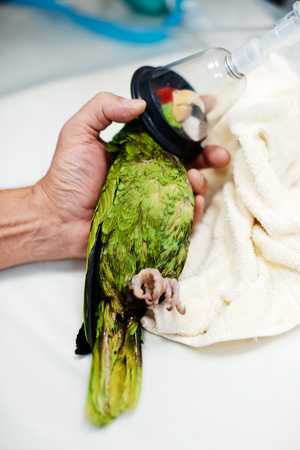
3- Dr Katherine Quesenberry
The exotic-pet specialist at the forefront of our changing relationship with animals.
In the waiting room of the Animal Medical Center in New York, Ally paces back and forth on her perch. The drive here was long and the 23-year-old blue-fronted Amazon parrot – her cage bundled up in a sweater and anchored to her owner’s lap – is agitated. Ally had a stroke a few years ago. Though she recovered from it, she’s now showing new signs of illness and was referred to the centre by a veterinarian for a second opinion. Minutes later, in the examination room, Dr Katherine Quesenberry, the centre’s director of the avian and exotics service, delicately inspects Ally as she flutters her wings and caws.
Today is a bird day. Dr Quesenberry, an elegant and serene woman whose soft-spoken accent reveals a slight southern twang, has already seen a sad little parakeet earlier this morning. His owner explained the bird couldn’t hop on to and play its favourite musical instrument because of a lame leg. In the afternoon another 23-year-old parrot, Pancho, is scheduled for a CT scan.
Dr Quesenberry practises exotic pet medicine, meaning she sees anything other than cats and dogs, be it tarantulas, rats, birds, gerbils, guinea pigs or monkeys. It’s a field that has changed tremendously since she started working here in 1984. Birds, her true passion, have always been popular patients but she used to see a lot more monkeys and ferrets. Those pets have largely been replaced by rabbits (she saw one this morning for its first check-up) as well as smaller furry animals and reptiles. Red-eared sliders are also common, she says, because people see them for sale in Chinatown and want to rescue them.
According to the American Veterinary Medical Association, approximately one in 10 American households owns an exotic pet. These animals, Dr Quesenberry explains, need special attention, especially when it comes to diet. “You can’t get bearded-dragon food at the grocery store for example,” she says. “You have to do a little more research into what’s proper. Same thing with turtles and tortoises.”
Yes, bearded dragons. The small lizards are very popular in New York – and, indeed, the rest of the country – because, contrary to what their name suggests, they’re docile, gentle pets. One of them, Tangerine, currently resides on the third floor of the Animal Medical Center in New York, which houses the exotics department. That’s where Dr Quesenberry preps her next patient, Pancho, the red-crowned Amazon parrot, for his scan: a routine examination that would never have been carried out on a bird just five years ago. That’s partly because of technological and scientific advancements but it’s also because our attitude to pets is changing.
In western societies, pets now enjoy an elevated status. In 2013, Americans spent nearly $56bn (€45bn) on their animal, according to the American Pet Products Association. In 2014 it’s estimated that the number will reach $58.5bn (€47bn), including more than $15bn (€12bn) on vet care. Pets that would, in the past, have been put down are now having their lives saved at huge expense. In late 2014, a vet in Melbourne performed the world’s first operation to remove a brain tumour from a goldfish.
It’s a trend that Dr Quesenberry is noticing, too. “I had a man yesterday come in with a hamster,” she says. “This person looked like he worked on Wall Street, I mean he had beautiful clothes on, a young guy in his thirties, and he brought this tiny little hamster.”
A procedure on a hamster can cost between $150 and $300 (€120 and €240). But when money is brought up, Dr Quesenberry says a lot of clients don’t care what it costs. Their priorities tend to lie on what they can do and if the animal is suffering – up to a certain point. “There’s usually a limit at $5,000 or $10,000 [€4,000 or €8,000]. But some people will absolutely put it on a payment plan,” she says.
How did it come to this and what does it say about us? Low fertility rates could explain why we, as a society, are spending much more time and money on pets than ever before. Whether couples choose to have fewer children or none at all, “the drive to nurture hasn’t gone away”, says Margo DeMello, director of the human-animal studies programme at the Animals and Society Institute, adding that each of her dogs, cats and rabbits bring her something different. The fact that rabbits were domesticated much later by man, for example, means they have retained more of their wild characteristics, just like guinea pigs. Birds such as Ally and Pancho, on the other hand, can be great companions for older adults and don’t need much day-to-day care.
“We tend to define pets as family members,” says Clinton R Sanders, a sociologist and the author of Understanding Dogs: Living and Working with Canine Companions. “Animal companions, be they dogs or iguanas, are socially available, seem to enjoy being with us, are non-judgmental, provide an outlet for nurturing, help to fill time and are the focus of love. What it says about us is that we need these elements in our lives and that some of the traditional sources can be more problematic or a mixed blessing than our interactions and relationships with non-human animals.”
In 1997, during the first-ever rabbits-only (as in topic, not attendees; we have not gone that far yet) veterinary conference organised by the House Rabbit Society, veterinarians spoke of a time when they were taught rabbits had no feelings. Today, Dr Quesenberry and her staff can talk about success stories such as Daisy’s, a three-year-old guinea pig who regained a taste for life after she had surgery to remove an infected toe. Science is developing in parallel to mentalities. “I can’t tell you how many people talk to me about making provisions for their birds in their will,” says Dr Quesenberry.
One of the things she’s most excited about in her field are the advancements made in diagnostic imaging. The Animal Medical Center is already a leader thanks to its radiology equipment but it’s also the first veterinary facility in the world to implement a complete interventional service that includes radiology and endoscopy (used for humans until now). It’s important to her because unlike the cardiologists, ophthalmologists and other specialists who work at the centre, Dr Quesenberry sees the whole gamut of health problems when it comes to exotics. From a hamster with heart disease to a parrot with cataracts or a rabbit with a broken leg, improving imaging will help professionals like her understand the anatomy of animals better and how disease affects them.
Up on the seventh floor, she and her staff meticulously strap Pancho, now sedated, to the CT scanner. As they close the door for the X-ray to start, Quesenberry stands behind the monitor. Radiographs indicating a serious condition, perhaps cancer, appear on the screen. After a thorough scan, she walks downstairs to meet privately with the bird’s owner. The department does surgery on birds but procedures are delicate and anaesthesia can be complicated. Still, Pancho’s owner, a young woman from New York, says she wants to try something. She just can’t put Pancho to sleep yet.
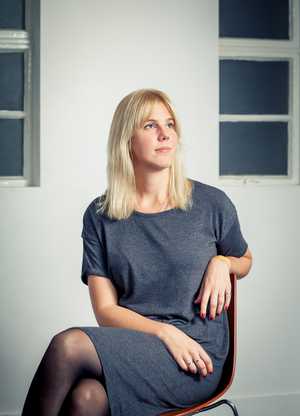
4- Nina Finnerud
The global nightclub hipster is also an official Norwegian ambassador.
As a rising Scandi-pop beat drowns the chatter of the early birds at Ja Ja Ja Festival, the event’s project manager Nina Finnerud watches the afternoon she curated unfold from the balcony overlooking the venue’s foyer. People crowd to the bar to order one of the bespoke Nordic cocktails – a Helsinki Hooligan or a Stockholm Syndrome – before heading towards the stage at the 1930s Queen Mary’s Great Hall. “Ja Ja Ja started as a Nordic club night five years ago; we were selling out so last year we decided to do a festival,” says Finnerud.
But 33-year-old Finnerud, originally from Oslo, is not just a pop promoter: she’s an ambassador. She works for Music Norway, a government-funded body set up to promote the country’s music abroad. Ja Ja Ja is a slice of Nordic soft power; a publicly financed attempt to influence the country’s image abroad.
That’s Nordic, rather than purely Norwegian, soft power: the second edition of the festival Finnerud has pulled together not just acts but also funding from Denmark, Finland and Iceland, as well as Oslo. Besides input from individual embassies there were also contributions from the Nordic Culture Fund, a pan-regional resource dependent on the inter-governmental Nordic Council of Ministers, which wields a hefty budget of DKK29m (€3.9m) to spend on around 250 cultural projects a year.
“We work really closely with the embassies,” says Finnerud. “They’re very supportive of all types of art; Norway in particular is very lucky.”
With an oil fund worth over NOK5.6trn (€660bn), Norway has the cash for artistic patronage that other countries would never consider, but this philanthropy isn’t just a generous gift for the good of culture. With a total annual export revenue of NOK247m (€29m), Norway’s music industry is worth investment.
“Our aim is to create an export out of it so that the money comes back but for the embassies it’s also about promoting Norway and having the country seen in a positive way,” she says. An innovative cultural profile could do wonders to cement the influence of what, despite a renaissance in mainstream Scandinavian pop over the last few years, remains underdeveloped.
“Nordic culture has established itself in the last few years,” says Finnerud. “Obviously this helps us but Norway also has a really interesting music scene of its own, with a lot of unique acts.” Sweden has historically had the upper hand when it came to pop success but Oslo-based duo Nico & Vinz recently topped the charts in the UK – something unseen since the days of A-ha – and acts such as Highasakite, picked for Finnerud’s line-up, are fast gathering speed. “They are fantastic, they’ve had a great year – selling out the whole tour.”
At 22, Finnerud left Oslo for Canterbury – where she studied fine art and art history – and eventually London. There she started working for independent record labels before landing a job at the Norwegian Embassy and moving on to the Music Norway Project two-and-a-half years ago. “A lot of my job consists of building a network and knowing the UK as a market; being ahead of what’s going to happen,” she says. “The UK is one of the most important markets because most of the key players for the major labels are here. It’s a tough market but Nordic music works well because it has such a different sound.”
Music Norway runs similar events in Berlin and has begun to work with other international festivals including South by Southwest. But Finnerud’s efforts are also centred on fostering an internal, lasting music industry that propagates future talent. That’s how Sweden did it, she explains: keeping the knowledge within the country rather than letting its best musicians emigrate elsewhere. With the help of its own talent and a few krone spent in the right places, Norway is on the right track to follow their lead.
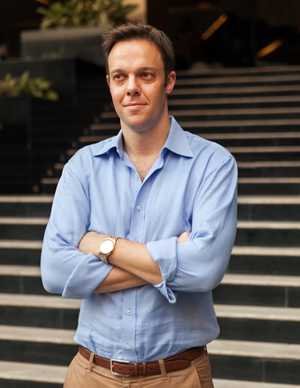
5- Blair Glencorse
The visionary head of the Accountability Lab – an NGO fixing on the cheap.
Most ngos begin in the same way. A westerner visits the developing world, is shocked by what they see and decide they must do something. In that way, the Accountability Lab is no different. British-born Blair Glencorse (pictured) worked at the World Bank, then as an adviser to the Afghan politician Ashraf Ghani, who is now the country’s president. In that time he saw the problems caused by corruption and a lack of transparency. “I came to the conclusion that accountability is at the heart of everything,” he says. “Unless we get that right we’re not going to get to the root of problems.” He had found his issue: the Accountability Lab was established two and a half years ago.
But here’s where Glencorse’s story changes. In an industry where the most influential agencies have become multimillion dollar organisations that show little flexibility or innovation, the Accountability Lab proves that small organisations that are careful with their money and work closely with local partners can achieve big results.
The Accountability Lab’s most intriguing project is a television show. Integrity Idol is an X Factor for honest civil servants in Nepal, a country where government corruption is endemic. More than 300 government employees have been nominated by members of the public for their “clean hands” approach to their jobs. A panel will whittle that number down to five, then each will be filmed carrying out their duties. TV viewers will then vote for their favourite. While most anti-corruption drives focus on highlighting those who commit it, this one aims to celebrate those who don’t.
Equally fascinating is the cost. Glencorse reckons his Washington-based organisation has spent less than $5,000 (€4,000) on the project. “You can get a lot done if you do the right thing in the right way,” he says. “Money isn’t the most valuable resource.”
When it comes to transparency and accountability, Glencorse practises what he preaches. Anyone can find out how much the Accountability Lab is spending, and on what. All expenses are detailed online, updated every day. In October, for example, they spent $70.02 (€56) on “miscellaneous travel expenses” and $1,273.56 (€1,020) on “office space and supplies”.
Aid used to be something that any right-minded liberal could support; “we” should help “them”. But that has begun to change. When aid is spent in the wrong way it can prop up dictatorships, undercut local businesses or create a culture of dependency where local governments know that someone else will step in to pick up the bill. Even when it’s spent in the right way, the method by which the money is raised can have negative consequences. Witness the backlash to the latest incarnation of Bob Geldof’s Band Aid single “Do They Know it’s Christmas?” The project has been criticised for a patronising paternalistic attitude that puts Africa in a box marked “helpless”.
Put simply, good intentions are not enough. “The aid industrial complex is dysfunctional and really hasn’t worked,” says Glencorse. “There have been 60 years of international aid and the incentives within the system are not in place to create sustainable positive change. There are lots of very good people within these organisations but they don’t function very well. There are whole big chunks of the aid system that don’t work very well. If we can set some standards and show the way we can perhaps begin to shift the system more broadly.”

6- Paul Michel
The tongue-in-cheek illustrator adding edge to the way we send greetings.
“I feel so awful for calling you a dick the other day. You definitely were being more of a douche bag.” “I heard from everyone that your baby’s a fat little idiot”. “If you ever murdered someone you could lay low in my basement for as long as you needed.” They’re not what you’d call run-of-the-mill greetings cards.
Under the name Mountain vs Plains, Paul Michel is the artist who needs his mouth washing out with soap while being patted on the back and bought a drink. The 32-year-old illustrator hit upon the idea of making his own range of potty-mouthed, off-colour cards while paying the rent as “the only straight young guy in the world who worked in a women’s boutique” that sold scent and candles in his hometown of Denver, Colorado.
“I was pretty confused about what I wanted to do with my life until I saw the shop was always full of people buying cards,” he says. “I thought maybe they were thirsting for something a little funnier and edgier.” Just how funny and edgy? “Well, it’s a pretty funky, liberal neighbourhood but I don’t print the first card I come up with,” says Michel on the phone from his home office. “With that one I was just thinking, ‘What’s the most fucked-up card you could send?’” And he has the right to fret a teeny bit over that one. “You fucked me. I trusted you and you fucked me” is a bit saucy, after all. Or just quite dark.
Michel’s work is a good, healthy mouthful of fresh ordure in the deodorised world of the greetings card where the saccharine rules with an orb of wan sentiment and a sceptre of pressed-flower pansyishness. The US is especially in thrall to a strange sort of brutal softness defined by the heavy-handed simpering of the Hallmark empire and its rhyming self-help rubric; those stanzas that shiver – bug-eyed – like shaved chihuahuas inside their padded, pastel cards. Cards, too, which are lunatic asylums for the terminally twee, the impersonally polite, the negatively positive, the downwardly “up”, the darkly bright. Stepford cards for Stepford Wives.
Michel has landed a decent blow on a cherished pop-culture punchbag: “Dear Canada: thanks for Nickelback, you dicks”. He has told it like it is when friends meet up in the absence of others: “We should get coffee soon and talk a bunch of shit about Kelly”. He’s even opened a Pandora’s box of creepiness: “I know we haven’t seen each other much but I’ve been touching myself to pictures of you a lot.” Any subjects he won’t touch? “Well, I was raised a strict Roman Catholic and I want my stuff to stay acceptable but be kind of taboo.” Interesting religious entanglement aside, Michel also says that he’s dealt with his own depression and that his cards come from both his “youngest brother, ever-the-entertainer public persona” and the serious self that is also a fine artist, working alone for much of the day.
How does this artist, raised Roman Catholic, deal with Christmas, then? With the “Negativity Scene” card featuring the Magi who hates carrying his staff everywhere, an angel Gabriel who’s sick of flying, a baby Jesus bitching about how uncomfortable the manger is and an attendant sheep complaining of the heat in Bethlehem. Light, but good. A bigger “C” than Christmas is tackled with what might euphemistically be described as brisk candour. On seeing the card in question, one sufferer – a mother of a friend of Michel – commissioned 10 more unflinching designs on the disease, so you have some sort of permission to laugh with impunity at, “I heard you have cancer. Do you remember that time I sprained my ankle really badly playing Frisbee?”
mountainvsplains.com
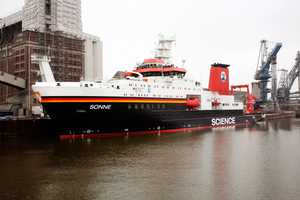
7- The ‘Sonne’
The cutting-edge research vessel that’s flying the flag for Germany via the world’s seas.
In a chilly port in northern Germany, a brand new research vessel is preparing to set forth to travel the oceans of the world in the name of scientific exploration. The Sonne (pictured), proudly bedecked in the colours of the German flag, is the most state-of-the-art vessel of its kind in the world and the envy of many an international oceanographic institute. Today, in its pristine and polished condition, the ship lives up to its name (meaning “sun”) and seems almost incongruous on such a drab, overcast day.
Walking across the deck as it waits quietly in the harbour, it’s not difficult to imagine what a hive of activity the Sonne will be when it eventually sets sail on scientific expeditions. There is space onboard for up to 40 researchers alongside a crew of 35, with enough fuel for 52 days of exploration at a time. Besides the normal engine rooms, mess and bridge there are labs, data centres and cold storage units.
Part of what makes the vessel unique, however, is its versatility: it will be able to carry a variety of devices, drills and measuring equipment that scientists can use to study everything from underwater currents to rock formations 200 metres below the seabed. It is also the country’s first ever deep-sea research ship: 12,000 metres of onboard cables allow scientists to lower these devices down to some of the darkest depths of the Pacific Ocean, such as the Mariana and Tonga trenches. And that’s exactly where the Sonne is eventually heading.
The ship will be spending all of 2015 in far warmer climes than her birthplace in Papenburg, where she was constructed by shipyard Meyer Werft. “We’ll be loading in Kiel and heading to Las Palmas in December, before docking in Santa Domingo and travelling through the Panama Canal,” says the ship’s corpulent captain Oliver Meyer, standing on the bridge and looking out over the ship’s enormous, gleaming bow. “We’ll be in the Pacific close to America all of 2015 and then moving on to New Zealand in early 2016. She won’t be returning to Germany until at least 2018 or 2019.” Before then, the ship will cover most of the world’s largest seas.
The Sonne, represents a huge investment (€124m to be precise) by the federal government and northern states of Germany in the furthering of scientific knowledge. It was commissioned to replace an older model (also called Sonne), a fishing trawler that was converted into a research vessel in the 1970s and that was a particular favourite among crew members and scientists alike. In 2015 the old ship will be sold to Argentina and will set sail for South America from its last port of call in Colombo, Sri Lanka. In its place, the new Sonne will be travelling the globe, representing Brand Germany and the hi-tech credentials of its home country.
For German oceanographers and climatologists, the investment made by the government in such a supreme vessel is a harbinger of a bright future for science. “Germany has always been one of the top countries in the world for ocean research,” says Dr Gabriele Uenzelmann-Neben, a geophysicist at the Alfred-Wegener Institute in Bremerhaven, barely able to contain her excitement as she inspects one of the ship’s eight on-board laboratories. “But the Sonne will definitely bring researchers to Germany and entice other institutes to collaborate with us. It’s a great thing for the country’s soft power.”
The Sonne effectively means Germany’s research fleet overtakes those of Japan and the US in its modernity and versatility. But as well as scientific research, there is also a commercial element: the Sonne’s jam-packed schedule will likely include exploration into potential undersea mining opportunities. The Federal Institute for Geosciences and Natural Resources is showing great interest in using the vessel to study manganese nodules, deep-sea silos of minerals and metals in the Indian and Pacific oceans. Over the past decade, the German government has bought rights to vast swathes of international waters precisely for this purpose.
It seems, then, that the Sonne will not merely cement Germany’s reputation as a pioneering scientific nation long into the future but could also help to boost its economic might. A soft-power winner and a long-term financial investment, suddenly that €124m is starting to look like a bargain.
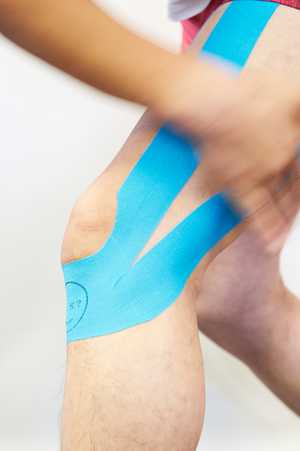
8- Ikuo Ogihara
The former downhill skiier who’s building a fitness empire out of humble sports tape.
Last April, Ikuo Ogihara was handing out free samples of colourful athletic tape before the start of the Ultra-Trail Mount Fuji race when the editor-in-chief of irunfar.com, Bryon Powell, dropped by. The race, a gruelling 168km of winding mountain trails, takes nearly two days to complete and runners endure freezing temperatures, strong winds, snow and occasional bear encounters.
Powell, a seasoned ultramarathoner, had flown from Moab, Utah, to cover the race but he was in pain: an unexpected flare-up of plantar fasciitis, also known as jogger’s heel. A trainer in Ogihara’s tent helped Powell cover the soles of his feet with a piece of stretchy tape that was the shape and size of a small hand. It was Powell’s first encounter with Gontex. “I’m a naturally sceptical person and had a healthy dose when trying Kinesio tape for the first time,” Powell says. “But using Gontex tape immediately reduced my discomfort and helped me to resolve the issue in two weeks.”
On a recent morning at his office in Tokyo, Ogihara wasn’t surprised by Powell’s initial doubts. “Gontex is the kind of product that you have to let people try out before they will buy it for themselves. That’s why we have spent so much time handing out samples at sporting events around the country.”
Ogihara’s company, Gon, launched Gontex five years ago at the Honolulu Marathon. It seemed to hold promise as a game-changer: Gontex was a stretchier, more colourful version of a family of elastic adhesive wraps called Kinesio tape. Developed in the 1980s by Japanese chiropractor Kenzo Kase, K-tape was said to give extra support to strained muscles and sprained joints, relieving pain and improving the flow of blood and lymphatic fluids. (Japan’s history of odd sports treatment trends includes the Phiten necklace, which is coated in titanium and thought to help improve circulation and reduce muscle stress.)
There is no scientific evidence to back such claims. Yet K-tape has become the latest must-have sports accessory, with Olympic athletes, ultramarathoners, professional footballers and American basketball stars endorsing the benefits of its use. Because it supports joints and muscles without restricting motion, K-tape has won a following among trainers and rehabilitation specialists. You’ll even find people at the beach or gym sporting K-tape strips.
When Gontex debuted, Japan was in the midst of a jogging craze. Unlike the standard beige athletic tape, Gontex’s line-up featured an array of colours: blue, orange, yellow, pink and black, and later purple and camouflage. Multicoloured tape that could help people with bad shoulders, knees and backs and also match their outfits was an easy idea to sell to a new generation of runners that wanted to look fashionable while getting fit.
As a former downhill skier for Japan’s national team Ogihara, 60, understands the mindset of competitive athletes. He has the stiff shuffle of a man who spent the first half of his life hurtling down ski slopes, getting injured and getting right back onto his skis. “I broke both ankles, dislocated my shoulders and wore down the cartilage in my knees,” he says. “My lower back hurts and I have to tape up my knees and the soles of my feet now every time I cycle, play golf or ski.”
Ogihara fell into the taping business while searching for something to do after retiring as the head of a mid-sized Japanese pharmaceutical firm. He has ramped up Gon to a six-person operation with annual revenues of around ¥10m (€70,000).
His office is little more than a room on the ninth floor of a nondescript office building in central Tokyo. Stacks of boxes filled with Gontex tape rolls from the factory in South Korea compete for space with cubicles and shelves that are cluttered with rolls from rival companies. Scattered about are vitamin supplements, icing pads and other products that Ogihara is considering for the future. On a table near the entrance is a pile of schematic drawings for a line of pre-cut tape for ankles, knees, and the arch of the foot that anyone can apply without the help of a trainer and that the company began selling in 2011. “The biggest obstacle to selling more of our product was that people don’t know how to tape up their own injuries. They needed a trainer to do it. Pre-cut tape solves that,” said Ogihara.
Gon has no hi-tech lab or research team. New products are developed through trial and error, led by Ogihara and his sales promotion manager Moowan Jang. They spent two years refining the design of the tape for the sole of the foot. “I ask friends who are former professional athletes, sports trainers and academics to test and critique our early prototypes and we get lots of feedback from actual users at running and trekking events,” says Ogihara.
To succeed, Ogihara’s team has to demonstrate to enough road and trail runners, footballers and mountain trekkers that a bit of Gontex in the right place can help tired limbs and possibly prevent injuries. So far he’s making progress, with 110 shops around Japan now selling Gontex products and several regional rehabilitation and chiropractic industry groups promoting the company’s tape. Turning a profit, however, could take another couple of years. “We don’t have a dream of making millions,” said Ogihara. “For me it’s more about helping to reduce the number of sports-related injuries.”


